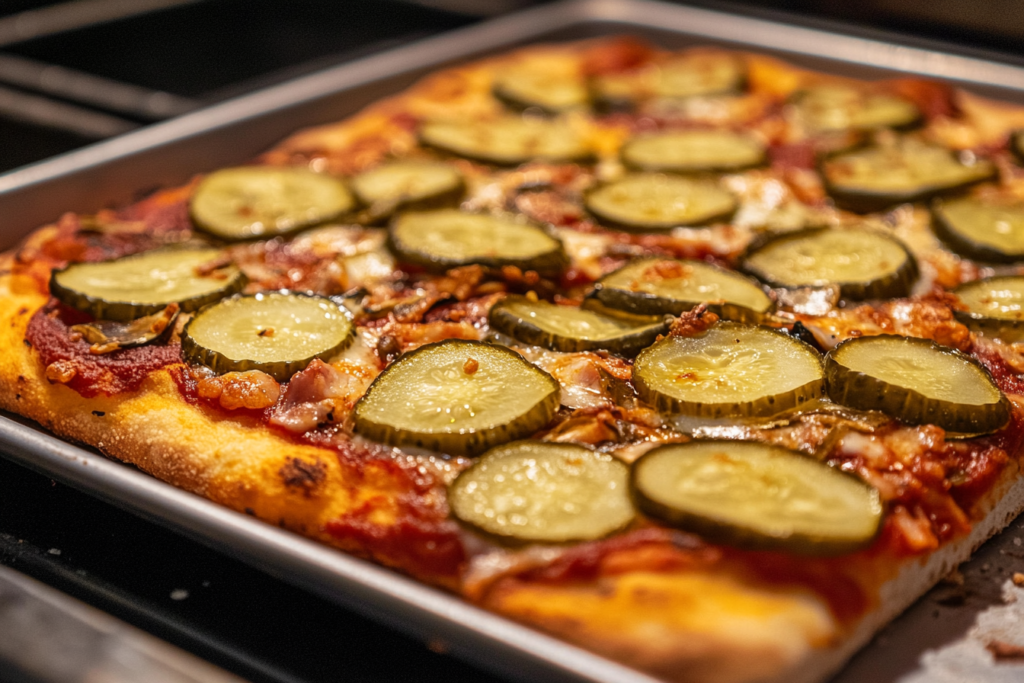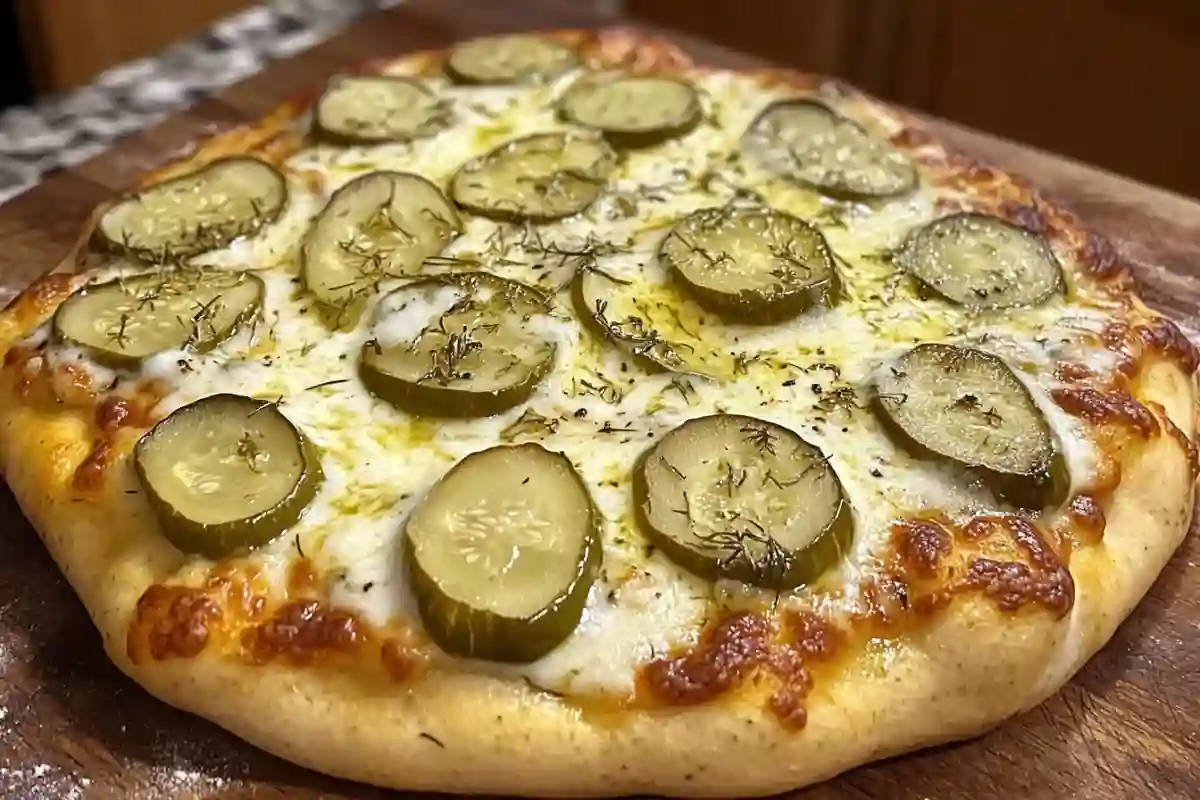Pickle pizza might sound unconventional, but its tangy flavors have sparked curiosity and taste buds across the United States and beyond. Who invented pickle pizza? This unique twist on the classic dish has an intriguing story that ties together culinary creativity, regional pride, and the love for pickles. In this article, we’ll dive into the history, origin, and variations of pickle pizza, unraveling the mystery behind its inventor and why it has become a popular culinary trend.
Introduction
Pickle pizza, a blend of briny pickles and savory pizza crust, has recently captured the attention of food enthusiasts. Its distinct flavor profile—offering both the familiar comfort of pizza and the sharp tang of pickles—makes it a standout among creative recipes. But who invented pickle pizza? This question has fascinated many, leading us to explore the origins, influences, and culinary culture that brought this dish to life.

The Inception of Pickle Pizza: A Culinary Tale
The question of who invented pickle pizza is not entirely straightforward. Several establishments have claimed the honor, each adding their own touch to this now-iconic dish. The trend initially took off in the Midwest region of the United States, where pickles are a staple in many homes. In particular, Minnesota is frequently credited with giving birth to the concept.
Around 2018, a small but popular eatery known as QC Pizza, located in Mahtomedi, Minnesota, brought pickle pizza into the spotlight. Their rendition, famously called “Kinda Big Dill,” quickly garnered attention for its flavorful combination of garlic-dill sauce, mozzarella cheese, and slices of dill pickles. This unique creation was soon featured on social media, drawing national interest.
However, it’s important to note that QC Pizza wasn’t necessarily the first to come up with the idea of using pickles as a pizza topping. The concept had likely been explored in various forms prior, especially in local pizzerias experimenting with unconventional toppings. The Midwest’s long-standing love affair with pickles, paired with the inventive nature of local pizza joints, made it inevitable that a pickle pizza would eventually emerge.
The Inspiration Behind Pickle Pizza
The idea of adding pickles to pizza may have seemed daring, but it was also born from a desire to mix unexpected flavors. It’s a common theme in American cuisine to combine traditional elements with unconventional twists. Here’s what inspired the inception of pickle pizza:
- Love for Pickles: Pickles have been a beloved snack and side dish in America for generations. The sharp, tangy flavor of pickles provides an excellent contrast to creamy, cheesy dishes.
- Fusion Cuisine Trend: The growing trend of fusion cuisine—combining different cultural elements to create something new—played a significant role. Pickle pizza is a product of American culinary experimentation, where chefs aren’t afraid to push boundaries.
- Social Media Influence: Social media platforms have played a huge role in popularizing pickle pizza. Viral posts and food challenges brought attention to the dish, sparking curiosity across various demographics.
Where Did Pickle Pizza Become Popular?
After its inception, pickle pizza soon spread to different parts of the United States. Many regions, particularly in the Midwest and Northeast, began featuring variations of this distinctive pie. Restaurants in Wisconsin, Illinois, and New York have all experimented with their own versions, often adding unique touches such as different cheeses, spicy pickles, or herbs to elevate the original concept.
Food festivals also contributed to its growing popularity. Pickle festivals, which are already known for their creative uses of pickles in foods, began showcasing pickle pizza, attracting pickle lovers and foodies alike. These events helped pickle pizza gain a reputation as a fun and adventurous food trend.
The Role of QC Pizza and Other Pioneers
QC Pizza was certainly instrumental in popularizing pickle pizza, but other key players contributed to its rise:
- Rhino’s Pizzeria in Upstate New York: Rhino’s Pizzeria also became well-known for its pickle pizza, adding another regional twist to the tale of who invented pickle pizza. Their version gained popularity through Instagram, thanks to the perfect blend of mozzarella, garlic sauce, and crunchy dill pickles.
- Local Pizzerias Across America: Beyond QC Pizza and Rhino’s Pizzeria, many smaller pizzerias began adding pickle-topped pizzas to their menus. Each establishment brought its own interpretation, often incorporating regional flavors like smoked cheese or adding spicy jalapeños for a kick.
How Pickle Pizza is Made: The Essential Ingredients
Pickle pizza typically uses a garlic or ranch-based sauce instead of traditional tomato sauce. This choice helps balance the tangy pickles and ensures that the flavors are complementary rather than overpowering. Below are the essential ingredients that make a classic pickle pizza:
- Pizza Dough: Like any good pizza, it all starts with a quality dough base.
- Garlic-Dill Sauce: This creamy sauce sets the foundation, providing a mild flavor that works well with pickles.
- Mozzarella Cheese: The classic cheese choice for most pizzas, mozzarella adds creaminess that balances the acidity of the pickles.
- Dill Pickles: Thinly sliced dill pickles are the star ingredient, providing the bold, briny taste that defines the pizza.
- Herbs and Spices: Often, dried dill, oregano, or even red pepper flakes are used to enhance the flavors.
Recipe Variations of Pickle Pizza
There is no one “right” way to make a pickle pizza. Many variations have emerged as the dish has grown in popularity. Here are a few creative twists on the original recipe:
- Spicy Pickle Pizza: Incorporates spicy pickles or jalapeños for added heat.
- Bacon Pickle Pizza: Adds crispy bacon pieces to bring an extra layer of flavor.
- Vegan Pickle Pizza: Uses plant-based cheese and a dairy-free sauce, catering to those following a vegan diet.
- Cheddar-Dill Pizza: Replaces mozzarella with sharp cheddar to create a more intense flavor experience.
The Cultural Impact of Pickle Pizza
Pickle pizza is more than just a food trend; it reflects the creative and experimental spirit of American cuisine. It embodies the willingness of chefs and home cooks alike to explore new flavor combinations and push the boundaries of what pizza can be.
In addition, the rise of pickle pizza is emblematic of how social media can influence food culture. Platforms like Instagram, TikTok, and Facebook have been instrumental in making niche dishes like pickle pizza into viral sensations. Videos featuring gooey cheese pulls and crunchy pickle bites have made audiences eager to try this quirky combination.
Pickle Pizza Across the United States: A Regional Overview
While the Midwest may have been the birthplace of pickle pizza, it did not take long for other regions across the United States to adopt this unique dish. Each region added its own twist to make pickle pizza their own.
The Midwest: A Pickle Pizza Stronghold
The Midwest, especially Minnesota, Wisconsin, and Illinois, has remained a hub for pickle pizza enthusiasts. The combination of locally made pickles and creamy cheeses available in this region makes it an ideal place for this dish to thrive. Midwest pizzerias often use regional ingredients such as Wisconsin cheddar, which adds a sharper profile to the already tangy pickle pizza.
The Northeast: A Gourmet Take on Pickle Pizza
In the Northeast, particularly in states like New York and Pennsylvania, pickle pizza has seen a more gourmet interpretation. Pizzerias here often incorporate specialty cheeses such as ricotta or goat cheese to add more depth to the flavor. The inclusion of herbs like rosemary and thyme has also contributed to a sophisticated version of pickle pizza that appeals to a more refined palate.
The South: A Spicy Twist
In the southern United States, pickle pizza has taken on a spicy twist. With the inclusion of hot peppers such as jalapeños and banana peppers, the Southern version of pickle pizza brings heat that complements the briny tang of pickles. Some pizzerias also add a touch of honey to balance the heat, creating a sweet and spicy dynamic that has become quite popular.
The West Coast: Health-Conscious Variations
On the West Coast, especially in California, the focus has been on health-conscious variations of pickle pizza. Pizzerias have been experimenting with gluten-free crusts, vegan cheeses, and organic pickles. These variations cater to the dietary preferences of many West Coast residents who prioritize healthier ingredients and sustainability.
Pickle Pizza in Popular Culture
Pickle pizza has not only gained popularity in restaurants but has also made its way into popular culture. Its quirky nature has made it a popular choice for food bloggers and influencers, who frequently feature pickle pizza in their content. From viral YouTube videos to TikTok challenges, pickle pizza has earned a reputation as a must-try dish for adventurous eaters.
In 2020, during the height of the pandemic, pickle pizza even became a trending item for those who took up cooking at home. Many home cooks shared their homemade pickle pizza creations on social media, showcasing their twists on the original recipe. This further solidified pickle pizza’s place as a popular, crowd-pleasing dish.
Pickle Pizza vs. Traditional Pizza: A Flavor Comparison
Pickle pizza provides a different flavor experience compared to traditional pizza. The tangy taste of dill pickles creates a stark contrast to the classic tomato sauce used in traditional pizzas. Below is a comparison of the two:
- Tanginess vs. Sweetness: Traditional pizza often has a slight sweetness from the tomato sauce, while pickle pizza is more tangy and acidic due to the pickles.
- Creaminess vs. Richness: Pickle pizza’s garlic-dill sauce provides a creamy texture, whereas traditional pizza relies on the richness of the cheese and tomato combination.
- Crunch vs. Smoothness: Pickles add a crunch that is absent in traditional pizzas, which typically have softer toppings such as pepperoni or mushrooms.
Pickle Pizza Pairings: Drinks and Sides
Pairing food and drink correctly can elevate any dish, and pickle pizza is no exception. Here are some drink and side options that complement the tangy flavors of pickle pizza:
- Beer: A crisp lager or a citrusy IPA pairs well with the tangy taste of pickles, balancing out the acidity.
- Lemonade: For a non-alcoholic option, lemonade provides a refreshing acidity that works well with the briny taste of the pickles.
- Garlic Breadsticks: Adding a side of garlic breadsticks can provide extra savory notes to complement the tangy pickles.
- Coleslaw: A serving of coleslaw on the side adds crunch and a different type of acidity, enhancing the overall meal.
Making Pickle Pizza at Home: Tips for Success
If you want to make pickle pizza at home, here are a few tips to ensure success:
- Use High-Quality Pickles: The pickles are the star of the show, so use high-quality, crunchy dill pickles for the best flavor.
- Don’t Overdo the Sauce: The garlic-dill sauce is essential, but too much can make the pizza soggy. Use just enough to cover the crust lightly.
- Thinly Slice the Pickles: Thin slices help the pickles cook evenly and blend well with the cheese.
- Experiment with Herbs: Fresh dill or a sprinkle of oregano can add a burst of flavor and elevate the overall taste.
The Future of Pickle Pizza: Here to Stay or Just a Fad?
The question on many people’s minds is whether pickle pizza is here to stay or if it’s just another passing food fad. Given its widespread appeal, it seems likely that pickle pizza will remain popular in some form for the foreseeable future. Its versatility allows for endless variations, and the strong social media presence suggests that it will continue to be a favorite among adventurous eaters.
Moreover, the trend of mixing unconventional ingredients is not going anywhere. As consumers become more open to trying new and unusual combinations, pickle pizza is well-positioned to remain a staple on many pizzeria menus. Its unique flavor profile and adaptability make it a dish that can evolve with changing tastes and preferences.
Who Invented Pickle Pizza: Final Thoughts
So, who invented pickle pizza? While there isn’t one single person who can claim to be the definitive inventor, QC Pizza in Minnesota played a pivotal role in bringing pickle pizza into the spotlight. The Midwest’s deep-rooted love for pickles, combined with culinary creativity and social media, turned this unique dish into a beloved food trend.
The story of pickle pizza is an excellent example of how a regional specialty can capture the attention of a nation. It shows that sometimes, the simplest ideas—like putting pickles on pizza—can create the most exciting culinary experiences.
Frequently Asked Questions (Who Invented Pickle Pizza?)
What Does Pickle Pizza Taste Like?
Pickle pizza has a unique flavor that blends the creamy, savory elements of pizza with the tangy, slightly sour taste of dill pickles. The garlic-dill sauce often used as the base enhances the pickle flavor without making it too overwhelming. It’s a combination of salty, tangy, and creamy that works surprisingly well.
Why Are Pickles Used on Pizza?
Pickles are used on pizza for their unique tangy flavor, which contrasts nicely with the creaminess of cheese and the savory crust. The pickles add a crunch that elevates the texture of the pizza, making it more interesting than a traditional topping.
When Did Pickle Pizza Become Popular?
Pickle pizza became widely popular around 2018, especially after being featured by QC Pizza in Minnesota. Social media further fueled its popularity, making it a well-known trend across the United States by 2020.
Is Pickle Pizza Healthy?
Like most pizzas, pickle pizza is not inherently a health food. However, it can be made healthier by using low-fat cheese, a thin crust, and reducing the sodium content by selecting low-salt pickles. Vegan variations can also make it suitable for different dietary preferences.
How Can I Make Pickle Pizza at Home?
To make pickle pizza at home, start with a pizza dough base, add a garlic-dill sauce, and layer it with mozzarella cheese and thinly sliced dill pickles. Bake until the crust is golden and the cheese is bubbly. Feel free to add extra toppings like herbs, spices, or even bacon to customize it to your taste.
Related article : Pickle Pie Pizza: The Ultimate Savory Twist on Classic Pizza

